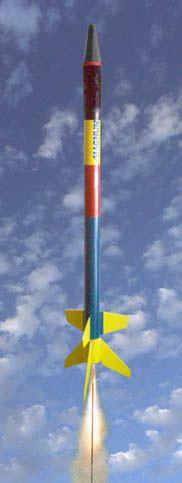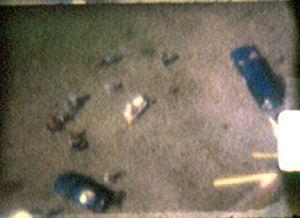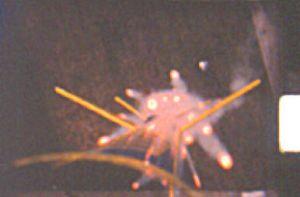| Construction Rating: | starstarstarstarstar_border |
| Flight Rating: | starstarstarstarstar_border |
| Overall Rating: | starstarstarstarstar_border |
| Manufacturer: | Modification |
 Brief:
Brief:
The Estes Magnum is a two-stage payload workhorse [now oop].
Construction:
The Magnum is a simple, BT-60 based rocket. It has three fins on each stage which the modeler cuts from printed balsa stock. Materials include booster and sustainer body tubes, two engine tubes, one engine block, centering rings, fin balsa, coupler, plastic nose cone, clear payload section, nose block, shock cord, shroud lines, launch lug, shock cord, tape disks, waterslide decals, and parachute.
There are no special tools required and the Estes instructions are simple and clear.
The only gotcha is the friction engine mounting method. On one flight the booster stuck on the sustainer which resulted in the sustainer engine burning through the booster engine tube. In order to eliminate this, a thin layer of paper around the sustainer motor nozzle end is scored lightly with a hobby knife and then removed so that when tape is applied around the engine staging joint it reduces the friction around the sustainer engine where it's inside the booster engine tube.
Modifications:
I made some changes. The engine mounts were originally designed with minimally effective paper centering rings around the engine tubes, which I replaced with balsa centering rings and ribs for better structural integrity.
The upper stage in the original design is 18mm, which I changed to 24mm. I also swapped the booster and sustainer fins. It looks better and is stable with the Cineroc but probably wouldn't be stable with the original supplied clear payload section and nose cone. I added offsets to the launch lugs to clear the Cineroc.
After 15 flights or so, the original sustainer body tube was shot so I replaced it with a new one but kept the original fins, 4 inches of the decal body tube section, and engine mount. So the pictured mongrel model is 4 inches longer than original.
Finishing:
It was originally finished in yellow-gold and has blue and aluminum waterslide decals. The decals with aluminum metallic are excellent and set the rocket apart from the run of the mill. The resulting look is long and sleek. This is a nearly perfect rocket. I only deduct half a point because, even back in the day, the original design with an 18mm sustainer made no sense... If you were afraid to launch it on a D12-0/D12-7 combination--because the C11s didn't exist yet, then put in a disclaimer that you need a couple of miles of open field in order to recover it.
Construction Rating: 4 out of 5

Flight:
Engine retention is via friction fit. Great friction care is required to result in perfect staging with the booster engine retained in the booster. Estes wadding works great. 16-20" parachutes are fine, depending on wind and softness of ground. Engines used for Cineroc payloads: On only a windless day, launching straight up with a C11-0/C11-5 combination results in a low apogee (~300-400 ft) with good, slow footage of the horizon and sky. Deployment comes a second or two after apogee with attendant chills.
My favorite combination is a D12-0/C11-5 because deployment comes at apogee. D12-0/D12-5 deployment is slightly before apogee. Single stage D12-3 flights are very safe but are not very interesting nor all that high (~250-300 ft).
Single stage E9-4 flights in light wind are perfect and having an extra inch or so of engine sticking out the back isn't a stability problem. I may try a straight up windless launch with a D12-0/D12-7 combination someday and also possibly composite E and F engines. The weight tends to shred parachutes, especially if you're launching into the wind so I'll eventually try separate parachutes for the Cineroc and body.

Recovery:
The Kevlar-on-the-engine-mount crowd won't like the paper/elastic mount, but it never zippers so I stick with it.
Flight Rating: 4 out of 5
Summary:
This is a great looking and flying rocket.
Overall Rating: 4 out of 5
Related Products
 |
 |
Flights
Sponsored Ads
 |
 |











